 |

|
 |

|
Closeup pictures: get images of eyepiece end and controls | telescope mount | captain's wheel and HA circle | lower pier | Pier and clock-drive mechanism | closeup of drive mechanism.
Generations of students and campus visitors will remember the 10-inch refracting telescope which graced the dome atop Gallalee Hall from 1950-2004. Built by J.W. Fecker, Inc., the first recorded observations with this telescope were soon after its installation on June 9, 1950. The anonymous first log entry lists the double stars Polaris, Epsilon Lyrae, Mizar, Albireo, and Gamma Virginis; the clusters M13, M22, M19, M6, M3, M11, M92, M23, M2, M15, chi-h Persei, and M5; and nebulae M57, M27, M17, M8, NGC 6543, NGC 7009; and the Andromeda galaxy. The telescope was originally equipped with a large-format wide-field camera (later replaced by an 8" Celestron Schmidt camera) on large piggyback brackets. The Schmidt was used, before the final surge in campus and surrounding lighting, for some spectacular photographs of wide Milky Way fields and large nebulae. The row below links to some of the better examples in the files from old student pictures, including that ever-popular test of observing capability, the Horsehead Nebula...
 |
 |
 |
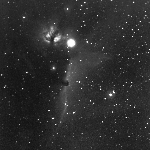 |
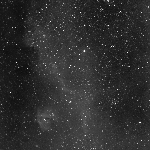 |
The dome features copper roofing plates and a cable-driven rotation system. The upper part of the dome is slowly regaining its earlier green patina, which some attribute to rain slowly leaching out the discoloration from air pollutants when the large paper mill was still operating nearby. The dome sits on a brick cylinder, with the telescope pier anchored to crossed I-beams in a concrete slab. The original pier includes two sections split about 53" from the floor; as a result of a change of plan and funding, the new telescope will also get a new pier, so the whole pier now goes with the 10-inch.
The telescope has a focal ratio near f/15, giving a substantial metal-bolted tube 14.5 feet long. Four eyepieces (three 1.25" and one 2") could be fitted into a four-position turret at the focus, moving on a large rack-and-pinion focusing tube with locking clamp. The German equatorial mount had large setting circles (the declination circle being 3 feet in diameter), and electric clock drive through a worm gear and wheel. Mechanical slow motions in both right ascension and declination are driven by manual wheels near the eyepiece, located just behind wheels to lock each coordinate. The mounting is a traditional German equatorial, with large setting circles in both right ascension and declination. A 3-inch f/10 finder is fitted.
The refractor has seen steady use for both class use and public events, some very heavily attended. Planetary events have been very popular and are observations for which such a classic refractor excelled. Hundreds of visitors viewed the impact spots on Jupiter during July 1994, many assisted by the large broadcast-TV camera that the robust telescope and mount held without so much as rebalancing. Nearly a decade later, similar crowds lined up for a view of Mars that would have pleased Percival Lowell. Comet Halley had people lining up across several floors of the stairway for a predawn glimpse.
A few images through the 10-inch itself will illustrate some of these uses:

 An item of special interest (left) is this time-lapse
video snippet
of a grazing occultation of Saturn from November 1997. We used
a small Sony surveillance camera at the telescope's prime focus,
which fed a large monitor and
incidentally kept a lot of onlookers from fighting over the eyepiece
at the critical time.
To the right is a color
photograph from the near-perihelic opposition of Mars in 1988, giving
a pretty fair representation of what it looked like through the
eyepece. This also shows why Mars isn't nearly as popular for public
viewing as folks expect it to be, and that the surface features
there are subtle enough to have sustained decades of argument about their
fine details.
An item of special interest (left) is this time-lapse
video snippet
of a grazing occultation of Saturn from November 1997. We used
a small Sony surveillance camera at the telescope's prime focus,
which fed a large monitor and
incidentally kept a lot of onlookers from fighting over the eyepiece
at the critical time.
To the right is a color
photograph from the near-perihelic opposition of Mars in 1988, giving
a pretty fair representation of what it looked like through the
eyepece. This also shows why Mars isn't nearly as popular for public
viewing as folks expect it to be, and that the surface features
there are subtle enough to have sustained decades of argument about their
fine details.
This telescope does provide superb lunar and planetary views, even under some unusual circumstances such as following Venus within three days of inferior conjunction, so that the thin crescent is seen broken into dancing threads by turbulence in our atmosphere. Double views are always unusually interesting as the picture below shows for the close conjunction of Venus and Jupiter on 23 February 1999. The Galilean moons are (left to right, which is to say east to west) Ganymede, Io about to go into eclipse, Callisto, and Europa offset just to its north, in this view taken as soon as night fell, which was shortly after closest alignment. Catching the wide range in surface brightness among these bodies was a daunting challenge for film; this exposure, showing the Galilean moons well, dramatically overexposes Venus, which had only 1/3 the angular diameter of Jupiter.
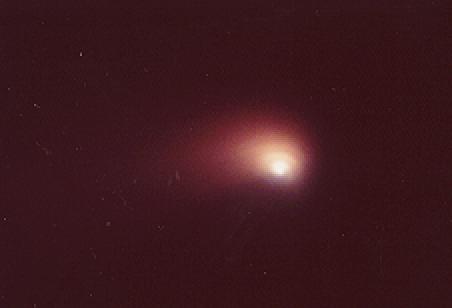 Going a bit deeper, here's a shot of comet Hale-Bopp on 4 March 1997
through the 10-inch refractor, showing the shells of dust expelled from
the nucleus as it rotated.
Going a bit deeper, here's a shot of comet Hale-Bopp on 4 March 1997
through the 10-inch refractor, showing the shells of dust expelled from
the nucleus as it rotated.
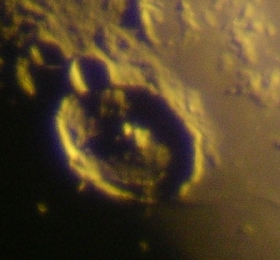 This recent
digital image of the region around the lunar crater Gassendi (done with
an afocal setup) shows the level of detail that the refractor could
deliver. The full image (linked to this cropped thumbnail, and utterly
unenhanced from the camera's JPEG output) includes
not only Gassendi and some of its floor rills, but the wrinkle
ridges seen at this low sun angle on the floor of Mare Humorum.
This recent
digital image of the region around the lunar crater Gassendi (done with
an afocal setup) shows the level of detail that the refractor could
deliver. The full image (linked to this cropped thumbnail, and utterly
unenhanced from the camera's JPEG output) includes
not only Gassendi and some of its floor rills, but the wrinkle
ridges seen at this low sun angle on the floor of Mare Humorum.
This telescope was disassembled on 4 November 2004, making room for its 16-inch replacement. It was sold at auction to a user who anticipotes erecting a new dome and putting it in full operation.
The current refractor was, in a sense, a replacement for the University's original 8-inch refractor, one of the largest in the US when installed in 1854. That instrument survived the burning of the campus by a Union army in 1865, with the objective lens hidden under the floorboards at the adjacent mental hospital. It was last used in about 1908, when the log records that the objective lens components were being renoved for cleaning. They may have fallen victim to the all-too-common fate of having the alignment marks needed to put them back together being washed off, never having been heard from again. The telescope and mount were melted down for scrap metal during World War II, as described in the Sky and Telescope article below. (Update: the original 8-inch objective may have been found, after tracing a peculiar and tortuous route through the hands of several people and having one of its lens elements replaced.)
It is a little-known fact that the University of Alabama was a pioneer in the teaching and advancement of astronomy during the two decades before the Civil War. That period has been the subject of a recent exhibition at the university's main library. Spotlighted were the school's only remaining original classroom building - the old observatory - and its instruments.
The observatory, constructed in 1843-44 to specifications of the astronomer Frederick Augustus Barnard Porter, is located in what was then an isolated spot in the southwestern part of the campus. It featured a large central section capped by an 18-foot-diameter revolving dome. At the west end was a transit room with a north-south slit in the roof, while to the east was a small office with a fireplace and, in time, a large classroom addition. Today the old building is almost completely hidden by later, larger structures; only the dome proclaims its former role.
In the era before modern communications, one important purpose of an observatory was to provide the correct time. The west room once contained a transit circle with a 4-inch objective, made by Troughton and Simms of London. This instrument, now lost, had a focal length of five feet and four-foot-diameter circle readable to a single arc second. It was used to determine the meridian-crossing times of stars with known celestial coordinates, which permitted accurate setting of the observatory's clocks, also imported from London. Both of these timekeepers, one by Molyneux and the other by Dent, survive.
Transporting delicate scientific instruments in the 19th century was difficult; getting them from Europe to inland Alabama posed real problems. The Molyneux sidereal clock, shipped from London early in 1840, sat in a Mobile warehouse for six months because the river to Tuscaloosa was too low for steamboats. Although the clock became tarnished from its sea voyage and long layover, Barnard was pleased with its accuracy and stated that "it is as perfect a piece of workmanship as could be desired" and "that its accuracy will render observations made with it... of high value".
The observatory dome contained an 8-inch refractor by Troughton and Simms, equipped with double-image and filar micrometers. Although this telescope has not survived, two smaller ones have. A brass 2-1/2-inch refractor by the same maker is currently on loan from the Smithsonian Institution; its original eyepieces and filters were found recently at the university. The tube of a 4-inch Dollond refractor was discovered in the attic of the physics building recently. This seven-foot wooden structure conveniently unscrews into two pieces at a central brass fitting; unfortunately, the objective and original stand of this handsome instrument are missing.
Yet another 19th-century telescope is also featured in the exhibition: a 2-inch wooden-tube refractor. One of the two micrometers seems to have survived as well. A brass instrument of that type, until recently in use at the university's present observatory, has "London" engraved on it in the same distinctive style as on the small Troughton and Simms telescope.
Then, as now, astronomy was taught not only by direct study of heavenly bodies, but also through illustrated lectures, and department reports in the 1850s mention a "magic lantern". Though this forerunner of the modern slide projector no longer exists, the university still retains 16 hand-painted English glass lantern slides of the period. One beautiful view of the Moon has a mounting with grooves, probably used to show phases and eclipses by means of overlays. Other topics include a "modern" (1850's) solar system with recently discovered asteroids, Halley's comet, nebulae, constellations, and Herschel's model of our galaxy.
The university's early efforts in astronomy were curtailed by the Civil War and its aftermath. A Federal raid under General John Croxton in the closing weeks of the conflict was devastating; almost the entire campus burned, including the extensive library. Although the observatory, located some distance away, escpaed the "flammable torpedoes" used to destroy other structures, its contents were seriously damaged. The last entry in the observatory transit log, by president L.C. Garland, reads:
On the 4th of April 1865 the University Buildings with the exception of the Observatory were burned by the Yankee raid. But the Observatory was forced open - all of its instruments were more or less injured, and many rendered entirely useless. One of two of the eye pieces of the Transit were carried away, together with the collimating eyepiece. The other lenses including the object lens were saved and sent for safe keeping to the Lunatic Asylum.
Although the observatory and some instruments survived, their use was restricted for teaching. Reports indicate that the large refractor remained in use until the 1890's; the subsequent fates of its objective, and of the transit circle, are unknown. The mount of the 8-inch was apparently the victim of an overzealous World War II scrap drive.
Barnard, on the other hand, had a long and fruitful career after leaving the university. Born in Sheffield, Massachussetts, on May 5, 1809, he graduated from Yale in 1828. He then taught at the American Institution for the Deaf and Dumb in Hartford, Connecticut, at Yale, and at the New York Institution for the Deaf and Dumb. His own impaired hearing never restricted his career.
In 1838 the University of Alabama hired the young scholar as professor of mathematics, which involved teaching astronomy, physics, and civil engineering as well. During his first year there he presented the trustees with a plan for the observatory that was finished five years later. Barnard visited England to purchase instruments, the last of which, the 8-inch refractor, was not installed until 1849.
Despite a heavy teaching load, Barnard found time for a wide variety of activities. He write scientific papers, almanacs, and aricles on opposing sides of political questions (under assumed names) for each of Tuscaloosa's two newspapers. In 1846, he and Garland were primarily responsible for settling the disputed border between Alabama and Florida.
Starting in 1841, Barnard developed a procedure greatly shortening the exposure time of photographic plates. In the same year, he opened a daguerrotype studio, inviting the public "to call and examine specimens of Landscape Views and miniature portraits from the life, executed by the pencil of nature". He taught photography at the university for the next 13 years and introduced one of the first organic chemistry courses in the U.S.
In 1951, learning of L. Foucault's pendulum experiments demonstrating the Earth's rotation, Barnard set up a public exhibition of this apparatus in the rotunda of the old state capital in Tuscaloosa.
Barnard left Alabama in 1854 for the University of Mississippi at Oxford, where he became chancellor before moving to the North in 1861. Later, he became president of Columbia College (now University). Barnard College, a separate women's branch of Columbia, was named after him even though, as a strong advocate of coeducation, he was against its establishment!
One interesting footnote to Barnard's life deserves mention. At Mississippi he obtained money to build an observatory, and ordered nothing less than the largest refracting lens in the world at that time - an 18-1/2-inch objective from Alvan Clark and Sons. This became famous during testing for the discovery of the predicted companion of Sirius. However, the lens was never delivered to Oxford because of the outbreak of war. Instead it was mounted in a telescope at Dearborn Observatory, now part of Northwestern University at Evanston, Illinois.
Today, astronomy at the University of Alabama is not just a thing of the past; a very active group works in the department of physics and astronomy. An undergraduate minor in astronomy is offered, while graduate students can do a doctoral dissertation in astrophysics.
The old observatory's domed building still exists behind the UA Police Station, now as home to the the Computer-Based Honors Program. It sports a nice shiny new finish gleaming on sunny days, as seen in this view on the summer of 2004:
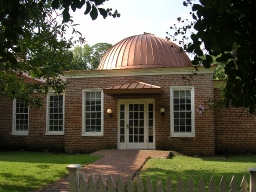
A refractor, particularly one on a purely mechanical mount with increasing play and some coupling between the slow-motion controls, is not very amenable to modern electronic imaging. Taking this into account, and driven by the growing workload of keeping the refractor in good working order, University approved its replacement in 2004 by a 16-inch Ritchey-Chretien reflector from DFM Engineering. The preparatory dome work for this replacement is in progress, and we expect installation of the new telescope by the end of 2004. We can all hope that it proves as rugged as its predecessor.
Last changes: 1/2005 © 2001